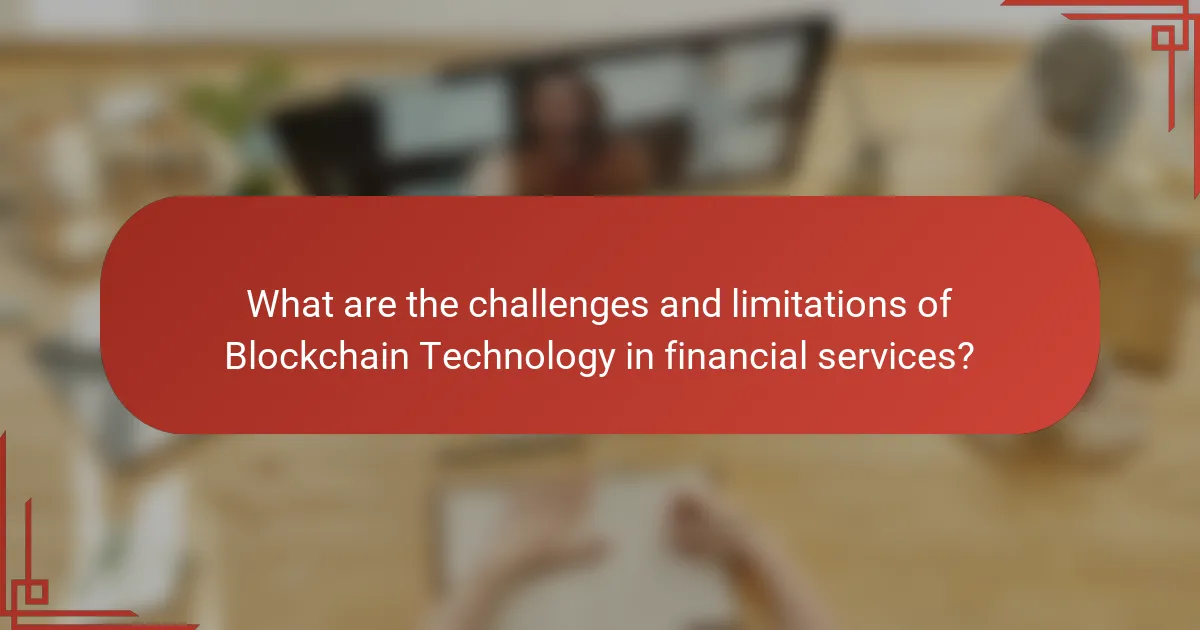Blockchain technology is a decentralized digital ledger system that securely records transactions across multiple computers, ensuring data integrity through cryptographic hashing. This technology is widely utilized in financial services, offering applications such as secure transactions, smart contracts, cross-border payments, and asset tokenization, which enhance operational efficiency and transparency. However, challenges such as scalability, regulatory uncertainty, interoperability, energy consumption, and security vulnerabilities persist, hindering broader adoption and innovation within the financial sector. The article explores these key features, applications, and limitations of blockchain technology in financial services.

What is Blockchain Technology?
Blockchain technology is a decentralized digital ledger system. It records transactions across multiple computers. This ensures that the recorded transactions cannot be altered retroactively. Each block in the chain contains a number of transactions. Once a block is filled, it is added to the chain in a linear, chronological order. The technology enhances security through cryptographic hashing. This makes it resistant to fraud and unauthorized access. Blockchain technology is widely used in financial services for secure transactions and transparency. Its implementation can reduce costs and increase efficiency in financial operations.
How does Blockchain Technology function?
Blockchain technology functions as a decentralized ledger that records transactions across multiple computers. Each transaction is grouped into a block. Once a block is filled, it is added to a chain of previous blocks, forming a chronological record. This chain is secured using cryptographic hashes. Each block contains a unique hash of the previous block, ensuring integrity. The decentralized nature means no single entity controls the entire blockchain. Consensus protocols, like Proof of Work, validate transactions before they are added. This process enhances security and prevents fraud. Blockchain’s transparency allows all participants to view the transaction history, fostering trust.
What are the key components of Blockchain Technology?
The key components of blockchain technology are decentralization, immutability, transparency, and security. Decentralization means that no single entity controls the entire network. This is achieved through a distributed ledger system where all participants have access to the same data. Immutability refers to the inability to alter or delete data once it has been recorded on the blockchain. This is enforced through cryptographic hashing. Transparency allows all participants to view transactions, fostering trust among users. Security is enhanced through cryptographic techniques that protect data from unauthorized access. These components work together to create a reliable and efficient system for recording transactions in financial services.
How does decentralization enhance Blockchain security?
Decentralization enhances blockchain security by distributing data across a network of nodes. This distribution makes it difficult for any single entity to control or manipulate the entire system. Each node maintains a copy of the blockchain, ensuring redundancy and resilience against data loss. If one node is compromised, the integrity of the overall network remains intact.
Additionally, decentralized networks require consensus among nodes for transaction validation. This process, often achieved through mechanisms like Proof of Work or Proof of Stake, adds layers of security against fraudulent activities. The more nodes involved, the harder it becomes for attackers to alter the blockchain.
Research shows that decentralized systems reduce the risk of single points of failure, which are common in centralized systems. For example, a 2020 study by the University of Cambridge highlighted that decentralized networks have a lower incidence of successful attacks compared to centralized models.
What are the fundamental security features of Blockchain Technology?
The fundamental security features of Blockchain Technology include decentralization, immutability, transparency, and cryptographic security. Decentralization reduces the risk of a single point of failure. It distributes data across multiple nodes, enhancing resilience against attacks. Immutability ensures that once data is recorded, it cannot be altered or deleted. This is achieved through cryptographic hashing. Transparency allows all participants to view transactions, promoting trust among users. Cryptographic security protects data through encryption, ensuring that only authorized parties can access it. These features collectively enhance the overall security of blockchain networks, making them suitable for financial services.
How does cryptography protect data in Blockchain?
Cryptography protects data in blockchain by ensuring confidentiality, integrity, and authenticity. It uses algorithms to encrypt data, making it unreadable to unauthorized users. Each block in the blockchain contains a cryptographic hash of the previous block. This links blocks securely and prevents tampering. Public-key cryptography allows users to sign transactions, verifying their identity. Only the holder of a private key can authorize transactions. This system enhances security against fraud and unauthorized access. Additionally, consensus mechanisms like Proof of Work require computational effort to validate transactions. This further protects the network from attacks. Cryptography is foundational to the trustworthiness of blockchain technology.
What role does consensus mechanism play in Blockchain security?
The consensus mechanism is crucial for blockchain security. It ensures that all participants in the network agree on the validity of transactions. This agreement prevents double-spending and maintains the integrity of the blockchain. Different consensus mechanisms, like Proof of Work and Proof of Stake, have unique security features. For example, Proof of Work requires substantial computational power, making attacks costly. In contrast, Proof of Stake incentivizes participants to act honestly, as they risk losing their stake. The consensus mechanism also helps in achieving decentralization, reducing the risk of a single point of failure. Overall, it forms the backbone of trust in blockchain systems.
Why is Blockchain Technology significant in financial services?
Blockchain technology is significant in financial services due to its ability to enhance security, transparency, and efficiency. It provides a decentralized ledger that records transactions securely. This reduces the risk of fraud and unauthorized access. Financial institutions can verify transactions in real-time. According to a report by Deloitte, blockchain can save banks billions in operational costs. Additionally, it enables faster cross-border payments. The technology also supports smart contracts, automating and streamlining processes. Overall, blockchain transforms traditional financial systems by improving trust and reducing costs.
How does Blockchain improve transparency in financial transactions?
Blockchain enhances transparency in financial transactions by providing a decentralized and immutable ledger. Every transaction recorded on the blockchain is visible to all participants in the network. This visibility ensures that all parties can verify transactions independently. The use of cryptographic hashing secures transaction data and prevents alterations. Once a transaction is added to the blockchain, it cannot be changed without consensus from the network. This feature significantly reduces the risk of fraud and manipulation. Furthermore, blockchain’s auditability allows for real-time tracking of transactions. Studies have shown that blockchain can increase trust among stakeholders by ensuring accountability and traceability in financial processes.
What are the implications of Blockchain for reducing fraud in finance?
Blockchain technology significantly reduces fraud in finance by providing a transparent and immutable ledger. Each transaction is recorded in a decentralized manner, making it difficult for any single entity to manipulate the data. This transparency enhances trust among participants in financial transactions.
Moreover, blockchain’s cryptographic security ensures that unauthorized access is minimized. Smart contracts can automate compliance and verification processes, reducing human error and fraud opportunities. According to a report by the World Economic Forum, blockchain could reduce fraud in financial services by up to 50% by 2025.
These features collectively create a more secure financial environment, deterring fraudulent activities. The decentralized nature of blockchain also means that there is no central point of failure, further protecting against fraud.

What applications does Blockchain Technology have in financial services?
Blockchain technology has several applications in financial services. It enables secure and transparent transactions. Smart contracts automate processes, reducing the need for intermediaries. Blockchain enhances fraud detection through immutable records. It facilitates cross-border payments with lower fees and faster processing times. Asset tokenization allows fractional ownership of real estate and securities. Decentralized finance (DeFi) platforms offer lending and borrowing without traditional banks. Finally, blockchain improves compliance and regulatory reporting through real-time data access. These applications demonstrate the transformative potential of blockchain in the financial sector.
How is Blockchain used in payment processing?
Blockchain is used in payment processing to enable secure, transparent, and efficient transactions. It allows for peer-to-peer transactions without intermediaries. Each transaction is recorded on a decentralized ledger, ensuring integrity and reducing fraud. Transactions are verified by network participants through consensus mechanisms. This reduces the need for traditional banking processes, lowering costs and processing times. According to a report by Accenture, blockchain can reduce payment processing costs by up to 40%. Additionally, blockchain provides traceability, allowing users to track the flow of funds. This enhances trust among parties involved in the transaction.
What are the benefits of using Blockchain for cross-border payments?
Blockchain technology offers several benefits for cross-border payments. It enhances transaction speed, allowing near-instant transfers compared to traditional methods that can take days. Blockchain reduces costs by eliminating intermediaries, leading to lower fees for users. It increases transparency, as all transactions are recorded on a public ledger accessible to all parties. This transparency helps to reduce fraud and improve trust between transacting parties. Additionally, blockchain provides security through cryptographic techniques, making transactions more secure against hacking. According to a report by McKinsey, blockchain can reduce cross-border payment costs by up to 50%. These benefits collectively improve the efficiency and reliability of cross-border transactions.
How does Blockchain facilitate real-time transactions?
Blockchain facilitates real-time transactions through its decentralized and transparent ledger system. Each transaction is recorded in a block and time-stamped. Once a block is filled, it is added to the chain in a linear, chronological order. This process eliminates the need for intermediaries, reducing transaction times significantly. Transactions can be verified and processed in seconds or minutes, depending on the blockchain network. For instance, Bitcoin transactions can be confirmed in about 10 minutes. Additionally, smart contracts automate processes and enforce agreements instantly. According to a study by the World Economic Forum, blockchain technology can reduce transaction costs by up to 40%. This efficiency makes blockchain an effective solution for real-time financial transactions.
What role does Blockchain play in smart contracts?
Blockchain serves as the foundational technology for smart contracts. It provides a decentralized and immutable ledger that records all transactions. This ensures transparency and trust among parties involved in a contract. Smart contracts are self-executing agreements with the terms directly written into code. Blockchain enables these contracts to execute automatically when conditions are met. The use of blockchain reduces the need for intermediaries, which lowers costs and speeds up transactions. Additionally, the security features of blockchain protect against tampering and fraud. Overall, blockchain enhances the efficiency and reliability of smart contracts in financial services.
How do smart contracts automate processes in financial services?
Smart contracts automate processes in financial services by executing predefined agreements without human intervention. They use blockchain technology to ensure transparency and security. When conditions are met, smart contracts automatically trigger actions such as payments or asset transfers. This reduces the need for intermediaries, leading to faster transactions. According to a report by the World Economic Forum, smart contracts can decrease operational costs by up to 30%. They also minimize errors associated with manual processing. Overall, smart contracts enhance efficiency and trust in financial transactions.
What are the advantages of using smart contracts over traditional contracts?
Smart contracts offer several advantages over traditional contracts. They automate execution, reducing the need for intermediaries. This leads to faster transactions and lower costs. Smart contracts are also more secure due to their encryption and decentralized nature. They are immutable, meaning once deployed, they cannot be altered. This prevents fraud and ensures trust among parties. Additionally, smart contracts provide transparency, as all parties can view the contract’s terms on the blockchain. According to a report by the World Economic Forum, smart contracts can save businesses up to 30% in transaction costs.
How does Blockchain enhance regulatory compliance in finance?
Blockchain enhances regulatory compliance in finance by providing transparent and immutable records of transactions. Each transaction is securely recorded on a distributed ledger, making it easily accessible for audits. This transparency reduces the risk of fraud and enhances trust among stakeholders. Smart contracts can automate compliance processes, ensuring that transactions adhere to regulations without manual intervention. Additionally, blockchain facilitates real-time reporting to regulatory bodies, improving responsiveness to compliance requirements. According to a report by Deloitte, implementing blockchain can lead to significant reductions in compliance costs and time. These attributes collectively strengthen the overall compliance framework in the financial sector.
What are the challenges of implementing Blockchain for compliance?
Implementing Blockchain for compliance presents several challenges. Regulatory uncertainty is a primary issue, as laws surrounding Blockchain technology are still evolving. Organizations often struggle to meet diverse compliance requirements across different jurisdictions. Data privacy concerns arise due to the transparent nature of Blockchain, which may conflict with regulations like GDPR. Integration with existing systems can be complex and costly, requiring significant resources. Additionally, the lack of standardized practices in Blockchain implementation complicates compliance efforts. Training staff on Blockchain technology and compliance requirements is often necessary, adding to operational costs. Overall, these challenges can hinder the effective use of Blockchain for compliance purposes.
How can Blockchain streamline reporting and auditing processes?
Blockchain can streamline reporting and auditing processes by providing a transparent and immutable ledger. This technology allows for real-time data access across stakeholders. Each transaction recorded on the blockchain is time-stamped and cannot be altered, enhancing data integrity. Auditors can verify transactions directly from the blockchain without relying on intermediary documents. This decreases the time spent on audits significantly. Additionally, automated smart contracts can enforce compliance and reduce human errors. Studies show that blockchain can reduce audit costs by up to 30%. Overall, blockchain enhances efficiency, accuracy, and trust in financial reporting and auditing.

What are the challenges and limitations of Blockchain Technology in financial services?
Blockchain technology faces several challenges and limitations in financial services. Scalability is a significant issue, as many blockchain networks struggle to process a high volume of transactions quickly. For instance, Bitcoin can handle about seven transactions per second, while traditional systems like Visa can manage thousands. Regulatory uncertainty also poses a challenge, as governments worldwide are still defining how blockchain fits into existing financial regulations. Interoperability is another limitation; different blockchain networks often cannot communicate with each other effectively. This fragmentation can hinder widespread adoption. Additionally, energy consumption is a concern, particularly for proof-of-work blockchains, which can require substantial electricity to operate. Security vulnerabilities exist as well, despite blockchain’s reputation for safety. Smart contracts can contain bugs that lead to financial losses. Lastly, there is a lack of skilled professionals in the blockchain field, which can slow down implementation and innovation.
What are the scalability issues associated with Blockchain?
Blockchain scalability issues primarily arise from limited transaction throughput and network congestion. Most blockchain networks, like Bitcoin and Ethereum, have a fixed block size and time intervals for block creation. For example, Bitcoin processes approximately 7 transactions per second. This is significantly lower than traditional payment systems like Visa, which can handle thousands of transactions per second. As more users join the network, the demand for transaction processing increases. This leads to longer confirmation times and higher transaction fees.
Additionally, the decentralized nature of blockchain complicates scalability. Each node in the network must validate transactions, which consumes time and resources. Solutions such as sharding and layer-2 protocols are being explored to address these issues. However, these solutions come with their own challenges, such as maintaining security and decentralization. The ongoing research and development in this area highlight the complexity of achieving scalability in blockchain technology.
How do transaction speeds affect Blockchain adoption in finance?
Transaction speeds significantly impact blockchain adoption in finance. Faster transaction speeds enhance user experience and satisfaction. They enable real-time processing of financial transactions. This is crucial for applications like payment systems and trading platforms. Slow transaction speeds can lead to delays and increased costs. These factors deter potential users and institutions from adopting blockchain technology. According to a study by the World Economic Forum, transaction speed is one of the top factors influencing blockchain implementation in financial services. Efficient transaction speeds can improve liquidity and reduce operational risks. Thus, optimizing transaction speeds is essential for broader blockchain adoption in the financial sector.
What solutions exist to address scalability challenges?
Solutions to address scalability challenges in blockchain technology include sharding, layer 2 solutions, and consensus mechanism improvements. Sharding divides the blockchain into smaller, manageable pieces, allowing for parallel processing of transactions. Layer 2 solutions, such as the Lightning Network, enable off-chain transactions that reduce the load on the main blockchain. Improvements in consensus mechanisms, like transitioning from proof-of-work to proof-of-stake, can enhance transaction speeds and efficiency. These methods have been shown to significantly increase transaction throughput while maintaining security and decentralization.
How does regulatory uncertainty impact Blockchain implementation?
Regulatory uncertainty significantly hampers blockchain implementation. It creates hesitation among businesses to invest in blockchain technology. Companies fear potential legal repercussions or compliance issues. This uncertainty leads to delayed project timelines and increased costs. According to a 2021 report by the World Economic Forum, 77% of executives cite regulatory concerns as a barrier to blockchain adoption. Without clear regulations, firms struggle to develop viable business models. This ambiguity also affects partnerships and collaborations within the industry. Overall, regulatory uncertainty stifles innovation and growth in blockchain applications.
What are the key regulatory considerations for financial institutions using Blockchain?
Key regulatory considerations for financial institutions using Blockchain include compliance with anti-money laundering (AML) laws, data privacy regulations, and securities regulations. Financial institutions must ensure that their Blockchain applications adhere to AML requirements to prevent illicit activities. Data privacy regulations, such as the General Data Protection Regulation (GDPR), require institutions to protect personal data on Blockchain networks. Furthermore, institutions must navigate securities regulations to determine if their Blockchain-based assets qualify as securities. Compliance with these regulations is crucial to avoid legal penalties and maintain consumer trust. Regulatory bodies like the Financial Action Task Force (FATF) provide guidelines to help institutions align with these requirements.
How can financial services navigate the evolving regulatory landscape?
Financial services can navigate the evolving regulatory landscape by implementing robust compliance frameworks. These frameworks should include regular assessments of regulatory changes. Financial institutions must stay informed about new regulations, such as those related to blockchain technology. Engaging with regulatory bodies can provide insights into upcoming changes. Training staff on compliance is essential to ensure adherence to regulations. Utilizing technology can streamline compliance processes and improve reporting accuracy. Data analytics can help identify potential compliance risks early. Collaboration with industry peers can also offer valuable perspectives on regulatory challenges.
What best practices should financial institutions follow when adopting Blockchain Technology?
Financial institutions should implement strict governance frameworks when adopting Blockchain Technology. This includes establishing clear policies for compliance and risk management. Institutions must also prioritize interoperability with existing systems. Ensuring compatibility can facilitate smoother integration and operation.
Robust security measures are essential to protect sensitive data. Utilizing encryption and multi-signature protocols can enhance security. Institutions should also conduct regular audits and assessments of their Blockchain systems. This practice helps identify vulnerabilities and ensures adherence to regulatory requirements.
Training staff on Blockchain fundamentals is crucial for successful adoption. Educated employees can better navigate the technology’s complexities. Collaborating with experienced Blockchain experts can provide valuable insights. Engaging with industry consortia can also aid in sharing best practices and standards.
These practices are supported by industry reports highlighting the importance of governance and security in Blockchain adoption. For instance, the World Economic Forum emphasizes the need for regulatory compliance and risk assessment in their 2020 report on Blockchain in Financial Services.
How can organizations ensure security during Blockchain implementation?
Organizations can ensure security during Blockchain implementation by adopting a multi-layered security approach. This includes conducting thorough risk assessments to identify vulnerabilities. Implementing strong encryption methods protects data integrity and confidentiality. Regular software updates and patch management reduce exposure to known vulnerabilities. Employing access controls ensures that only authorized personnel can interact with the blockchain. Training employees on security best practices mitigates human error. Utilizing smart contracts can automate and enforce compliance with security protocols. According to a report by the World Economic Forum, organizations that implement these measures significantly reduce the risk of security breaches.
What strategies can enhance collaboration among stakeholders in Blockchain projects?
Enhancing collaboration among stakeholders in Blockchain projects requires clear communication and shared goals. Establishing a common vision aligns interests and fosters teamwork. Regular meetings facilitate updates and address concerns promptly. Utilizing collaborative tools streamlines information sharing and keeps all parties informed. Transparency in decision-making builds trust among stakeholders. Engaging stakeholders early in the project ensures their input is valued. Training sessions on Blockchain technology enhance understanding and participation. These strategies lead to more effective collaboration and project success.
Blockchain technology is a decentralized digital ledger system that enhances security, transparency, and efficiency in financial services. This article explores the fundamental components of blockchain, including decentralization, immutability, and cryptographic security, while examining its applications in payment processing, smart contracts, and regulatory compliance. Key challenges such as scalability, regulatory uncertainty, and security vulnerabilities are also addressed, providing a comprehensive overview of how blockchain technology transforms financial operations and reduces fraud. The implications of adopting blockchain for enhancing transaction speed and cost-effectiveness are highlighted, making it a pivotal innovation in the financial sector.


